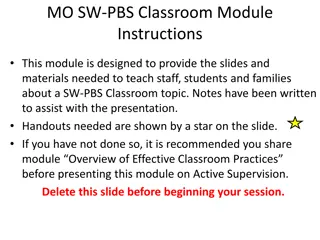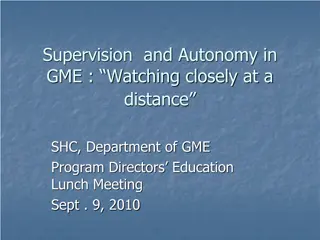Understanding Market Conduct Supervision Processes: Tools, Policies, and Outcomes
Market Conduct Supervision involves overseeing financial service provider activities to ensure trust, fair treatment, and compliance with regulations. It includes policies, processes, and tools such as monitoring, mystery shopping, and sanctions to achieve inclusive, competitive, and ethical marketplaces. The focus is on consumer protection, transparency, and professionalism in commercial decision-making.
Download Presentation

Please find below an Image/Link to download the presentation.
The content on the website is provided AS IS for your information and personal use only. It may not be sold, licensed, or shared on other websites without obtaining consent from the author. Download presentation by click this link. If you encounter any issues during the download, it is possible that the publisher has removed the file from their server.
E N D
Presentation Transcript
MARKET CONDUCT MARKET CONDUCT SUPERVISION PROCESSES SUPERVISION PROCESSES Market Conduct Supervision Training Program Armenuhi Mkrtchyan 6-10 August 2018, Harare
O OVERVIEW VERVIEW What is MC and what is NOT Tools of Supervision Process of Supervision 2
What is Market Conduct Supervision and what is NOT?
W WHAT HATIS IS M MARKET ARKET C CONDUCT ONDUCT S SUPERVISION UPERVISION Set of policies, processes and tools used to oversite FSP activities so that they will achieve TRUST & FAIR TREATMENT 1. INCLUSIVE AND COMPETITIVE MARKETPLACE 2. SUITABILITY 3. TRANSPARENCY AND MARKETING 4. ETHICS AND PROFESSIONAL TRUST & FAIR TREATMENT and 7 MC outcomes: STANDARDS 5. DUE CARE 6. SAFETY AND SECURITY 7. LEGAL ENVIRONMENT MARKET CONDUCT POLICY OUTCOMES UNDER THE CONTROL OF FSPs
M MARKET ARKET C CONDUCT Making commercial decisions instead of FSP ONDUCTIS IS NOT NOT That every firm must offer an identical level of service businesses have different resources and ways of doing things That the supervisory agency has the final say on which products consumers should want or be sold That customers are no longer expected to make decisions or take responsibility for them Making commercial decisions instead of consumers That it will create satisfied customers -> a satisfied customer could still be treated unfairly and not know it (and vice versa) Satisfying consumers
What are the TOOLS for Market Conduct supervision?
S SUPERVISION UPERVISION T TOOLS NEW TOOLS OOLS TRADITIONAL Monitoring of webs, TV ads, publications Mystery shopping Off-site Sales, disclosure Disclosure proper language, suitability, not misleading Focus Group On-site Inspections Sanctions, fines, bans Order corrective actions Suspend/terminate license Raised eyebrows & warning letters Public warning/guidance name and shame Enforceme nt Enforcement
OFF OFF- -SITE MONITORING SITE MONITORING Objectives & types of off-site examinations Areas and topics for off-site examination Methodology Sources of information about financial institutions Ongoing and targeted offsite activities to monitor communication of financial institutions Follow-up actions Public guidance based on offsite examination results
O OBJECTS BJECTSOF OF O OFF FF- -S SITE ITE MARKET What is happening in general? What are the trends? Are there any emerging issues? All/most of institutions are involved Establish supervisory benchmarks POLICIES What is the main polcies? Are they comply with laws? Are they bearing consumer protection risks? Guidelines, internal regulations, codes of conducts and policy documents of FSPs PRACTICES What are the practices of the FSPs? Disclosure, transparency, etc.
O OBJECTIVE BJECTIVEOF OF O OFF FF- -S SITE ITE MONITOR situation/indicators that may identify problems or trigger the need for onsite inspections Establish SUPERVISORY BENCHMARKS VERIFYCOMPLIANCE with market conduct rules and consumer protection requirements. Provide support for enforcement of rules. Provide information and background for onsite inspections MAKE RECOMMENDATIONS for new regulations and guidance to the industry Monitor risks Supervisory benchmarks Verify compliance Make recommendations
T TYPES YPESOF OF O OFF FF- -SITE SITE S SUPERVISION UPERVISION Market Monitoring Casework Thematic Review Finding emerging issue across market Focus on individual FSP Specific topic , market practices, and/or market segment Planned - the annual plan of examinations, quarterly/semiannually Ad-hoc - as a response to an emerging issue 80% 20% 11
M MARKET ARKET M MONITORING ONITORING - - T TRANSPARENCY RANSPARENCY All channels websites Regularly (have a plan), quarterly, semiannually TV Risky institutions and areas Radio Printed materials
CASEWORK CASEWORK Focus on individual FSP Dealing with a specific issue or general, EXAMPLES Complaint Handling process of particular FSP Agents taking illegal payments for services Reaction to consumer complaints or specific referrals from other sources
T THEMATIC HEMATIC R REVIEW EVIEW Specific topic , market practices, and/or market segment All or representative sample of FSPs When - recent or planned market changes, complaints, effectiveness of regulation, emerging issue, etc. EXAMPLES New regulation on KFS and its implementation Agents taking illegal payments for services, finding which FSPs fail to comply
P PROCESS ROCESSOF Identification of FSPs and theme for supervision Scope of review OF O OFF FFS SITE ITE 1 Data collection & request for information 2 Assessment of information 3 Enforcement 4 Follow-up action 5 Communication of results 6 15
H HOW OWTO TOCHOSE CHOSEINSTITUTIONS INSTITUTIONSFOR FOR S SUPERVISION UPERVISION Institution s current risk assessment (risk rating) Size / market share (turnover, assets / liabilities, number of customers, distribution network) Products offered / services provided Public image Diversification of samples (good practices vs. poor practices) Emerging risks 16
D DATA ATA C COLLECTION OLLECTION & R & REQUEST EQUESTFOR FOR I INFORMATION NFORMATION There are four ways to collect data that will form the base of the supervision: Monitoring and collection of publicly available data: The supervisor should monitor, collect and assess publicly available data (indirect offsite examination) Regulatory Data: Data that is required from each institution by the supervisor on some periodic frequency. This could be both qualitative and quantitative (direct off-site examination) Information request: Information is formally requested from the financial institution(direct offsite examination) Data sharing: Relevant data available to other public authorities or entities is shared with the supervisor (and vice versa) 17
DATA COLLECTION: S DATA COLLECTION: SOURCES Consumer contracts and other contractual documents such as terms and conditions Key fact statements and other disclosure documents Internal regulations (body of internal rules) Written policies and procedure manuals Internal codes of conduct or industry codes of conduct Advertising and marketing materials QUALITATIVE OURCESOF OF I INFORMATION NFORMATION Complaints reports and complaints statistics Financial data (e.g. loan performance, deposits, etc.) QUANTITATIVE
M MYSTERY YSTERY S SHOPPING Definition and benefits for supervisors Design and methodology Communication of results Follow-up actions Public guidance based on mystery shopping results HOPPING
M MYSTERY YSTERY S SHOPPING HOPPING: D : DEFINITION EFINITION A technique that involves the use of individuals trained to experience and measure customer service processes by acting as potential customers and reporting backand analyzing on their experiences in a detailed and objective way Mystery shoppers perform specific tasks such as: purchasing a product, asking questions, registering complaints; or just behaving in a certain way. Provides a detailed insight into the way financial institutions provide services and sell products to their customers 20
O OBJECTIVE BJECTIVEOF OF M MYSTERY YSTERY S SHOPPING HOPPING Effective tool that enables supervisors to: Verify and evaluate how the FI treats its customers; in regards to the implementation of regulatory requirements for market conduct Assess levels of firms compliance with rules; Examine the experience consumers have with financial institutions DISCOVER: to carry out research in an area that has been identified as potentially high risk VERIFY: to address existing concerns about a specific financial institution or within a market segment Allows the supervisor to verify results of analytical work, public opinion or received complaints through an objective and independent tool
WHENTO USE MYSTERY SHOPPING As a supervisory tool, mystery shopping may be used to: Identify level of compliance with existing rules with scenarios designed to assess compliance with key regulatory provisions Inform supervisory planning basis for a plan for thematic inspections Inform development of the regulatory framework 22
M MYSTERY YSTERY S SHOPPING HOPPING T TECHNIQUES ECHNIQUES There are three types of mystery shopping techniques: Mystery visits (on-site mystery shopping in branches and other sales points used by the financial institution or its distributors) Mystery telephone calls Mystery e-mail requests and / or website visits For each of the types, different tools may be used for the collection of information: Simple questionnaires Detailed shopping scenarios including complete audio and video recordings (if legally allowed) 23
P PROCESS ROCESSOF Setting objectives and goals OF M MYSTERY YSTERY S SHOPPING HOPPING 1 Identification of targets 2 Scenarios and questionnaires design 3 Defining and training shoppers 4 Pilot stage and evaluation of scenarios & questionnaires 5 Data collection 6 Analysis 7 Summary report 8 Follow-up actions 9 24
A F A FEW EW C CONSIDERATIONS ONSIDERATIONSFOR FOR M MYSTERY YSTERY SH SHOPPING OPPING Credibility: The scenario must be realistic, i.e. represent natural and typical consumer behavior in the financial market: Straightforward-easily understood and applied Mystery shoppers should fit the profile of appropriate purchasers, and have a level of familiarity with the product Ethicality: FIs must be aware that mystery shopping can be used by the supervisor Safety: Mystery shoppers shall not be put at risk: Objectivity: Should be focused on objective questions aimed at gathering factual information 25
F FOCUS OCUS G GROUP ROUP R RESEARCH ESEARCH
F FOCUS OCUS G GROUP ROUP R RESEARCH ESEARCH It is a form of qualitative research consisting of interviews in which a group of people are asked about their perceptions, opinions, beliefs, and attitudes towards a product, service, concept, advertisement, idea, or packaging.
I IT TLOOKS LOOKS L LIKE IKETHIS THIS
W WHEN HEN I IT T C CAN AN B BE E U USED SED When 1. Different opinions on the same issue during supervision Example 1. Advertisement is misleading 2. Design of regulation reflecting consumers perspective 2. Key Facts Statement template 3. Existing templates for complaints handling 3. Assessing effectiveness of existing practice
S SELECTION ELECTION O OF F M MYSTERY YSTERY S SHOPPERS HOPPERS Mystery shoppers may be recruited from: Supervisory staff: highly experienced and knowledgeable but more inclined to biased (as they have different focus and higher financial capability than average consumers), some supervisors may also face a capacity problem; External appointees (outsourcing): more objective, but thorough training needed. Volunteers usually students 30
ON ON- -SITE INSPECTIONS SITE INSPECTIONS Purpose of market conduct onsite supervision and types of inspections Annual work plan Preparation of an inspection Conducting inspections Inspection report and follow-ups
O OBJECTIVE BJECTIVEOF OF O ON N- -S SITE ITE Verify information and clarify issues collected previously to the inspection Observe and collect information on internal control, significant activities, risks over 7 MC outcomes Update the FSP s risk profile Make recommendations regarding deficiencies Verify what you know Find out what is not possible during off-site Update risk profile Make recommendations
O OBJECTIVE BJECTIVEOF OF O ON N- -S SITE ITE People Mindset, culture Meet, discuss and observe management and employees, understand their attitude, mindset, corporate culture over MC, Assess their understanding of the rules, what qualifications the front office has Processes Policy & Implementation, risk control Assess how TCF is internalized by FI Business Model Riskiness What is the model of retail activity of the FSP? What MC risks bear the business model?
T TYPES YPESOF OF O ON N- -SITE SITE I INSPECTIONS NSPECTIONS Comprehensive Thematic Targeted Full RBS - diagnostics Cover all areas related to consumer interactions Priorities based on risk assessment for each institution e.g. review of redress mechanisms in the banking sector Combined with desk- review Focus on a particular area or product Based on issues identified 34
Make an annual work plan Plan O ON N- -S SITE ITE P PROCESS ROCESS Make preparation for the inspection Prepare Conduct Inspections Conduct File the report and recommendations Discuss it with stakeholders, FSP s management Report Follow up if recommendations are implemented by FSP Follow-up
P PREPARATION REPARATION: C : COLLECTION OLLECTIONOF OF I INFORMATION NFORMATION Be clever, seem clever: do not go to onsite inspection before knowing as much as you can Collect as much information as possible from internal and external sources before requesting info from FI. A) Internal, B) external sources + C) information provided by FI 36
P PREPARATION REPARATION: C : COLLECTION OLLECTIONOF OF I INFORMATION NFORMATION Internal sources External sources: Media coverage related to the institution Internet and social media Complaints received (both FI s reports and external parties such as a financial ombudsman) Advertisements FI s website Data regularly reported to the supervisor and off-site analysis reports Information used to conduct the latest risk assessment Prior inspection reports and supporting documents Licensing information (incl. fit & proper info on management) Any relevant previous correspondence Complaints received about the institution 37
P PREPARATION REPARATION: I : INFORMATION NFORMATIONREQUEST REQUESTTO TO FI FI Bank s strategy (strategic plan) Organizational arrangements Manuals and policies concerning market conduct Internal control monitoring and auditing relevant materials Sample of consumer complaints and telemarketing files/records Staff remuneration and incentive policies Current contract documentation of retail products Information about product development/approval process Marketing programs, advertisements, similar Results of relevant internal audit reviews Compliance reports Complaint analysis reports Any relevant Board minutes 38
P PREPARATION REPARATION: I : INSPECTION The Inspection plan should identify: NSPECTION P PLAN LAN Issues that will be reviewed/verified on-site Access to complaints and other management systems Additional documentation that may be requested on-site Employees of the financial institution that will be interviewed/observed: CEO / members of the board Front office and sales managers Compliance officer / Internal auditor Employees responsible for complaints handling Marketing, other managers 39
P PREPARATION REPARATION: I : INTERVIEW NTERVIEW T TEMPLATES EMPLATES Interviews are a significant part of onsite inspections. The team should draft interview templates for each type of manager or employee selected for interviews. Questions on position, qualification, work experience, recent trainings, reporting lines/methods Work-related questions on tasks and responsibilities, internal rules and policies to follow, internal controls applied Specific work-related questions according to the position of the manager / employee, and the focus of the inspection Specific questions arising from the documentation review 40
F FOLLOW OLLOWUPS UPS: I : INSPECTION NSPECTION R REPORT EPORT The primary purpose of the inspection report is: To prepare the grounds for any necessary enforcement action To communicate examination findings to the board of directors and senior executives of the supervised financial institution. The inspection report should be a standalone document that will contain all relevant information to assess any potential enforcement action and at the same time inform the management of the financial institution about the results of the market conduct analysis and the legal reasons for any requested changes. 41
F FOLLOW OLLOWUPS UPS: W : WORK ORK P PAPERS APERS All interviews, observations and analysis should be recorded in the supervisory team's work papers and documented in the conducted reviews. All information collected and all records created during the inspection should be included in the work papers and their annexes (work performed during the inspection, sampling process used, findings and violations noted during the examination, copies of relevant documents). All work papers and related documentation from the examination should be stored in an electronic form. If the supervised financial institution is able to provide a document only in hard copy form, the examiner should scan the document for future reference and return the original. 42
F FOLLOW OLLOWUPS UPS: U : UPDATE PDATETHE THEIF IF S S R RISK ISK P PROFILE ROFILE Once the inspection is over and decisions about possible corrections and / or sanctions made, the supervisory team should update the market conduct assessment matrix. The matrix should be again updated when the supervisor verifies that the financial institution fully implemented requested changes (assuming the requested changes have an impact on the risk profile of the financial institution). 43
E ENFORCEMENT NFORCEMENT
T TRADITIONAL RADITIONAL V V N NEW EW Sanctions, fines, bans Order corrective actions Suspend/terminate license Raised eyebrows & warning letters Public warning/guidance name and shame
There are some processes are important to set up regardless what tools are used
R REPORTS EPORTS Any supervision action should have filed into REPORT with key findings and recommendations Should be compiled nicely and provided to top management Report should include: Key messages Consolidated analyses Analyses by institutions Recommendations and actions
D DATA ATAB BASE ASEOF OFFINDINGS FINDINGS All data should be in one place where all supervisors have access to. PURPOSE Reduce asymmetry among supervisors Files should be compiled in an organized way by institutions Purposes (monitoring reports, etc) Keep institutional memory Increase effectiveness and efficiency of supervisors PASSPORT/ID of each institution
G GUIDELINES UIDELINES/M /MANUALS ANUALS Manuals should be for each regular process: Off site monitoring (web, TV, Radio ) On-site Mystery shopping Database management and data recording Hot line . PURPOSE Regulate processes so that minimum standards can be kept across supervisors Increase quality of coordination and cooperation level (especially between departments)
Q QUESTIONS UESTIONS? ? Armenuhi Mkrtchyan Head of Consumer Protection and Financial Education Centre, Central Bank of Armenia armenuhi.mkrtchyan@cba.am www.cba.am for Armenian legislation www.abcfinance.am financial education website























